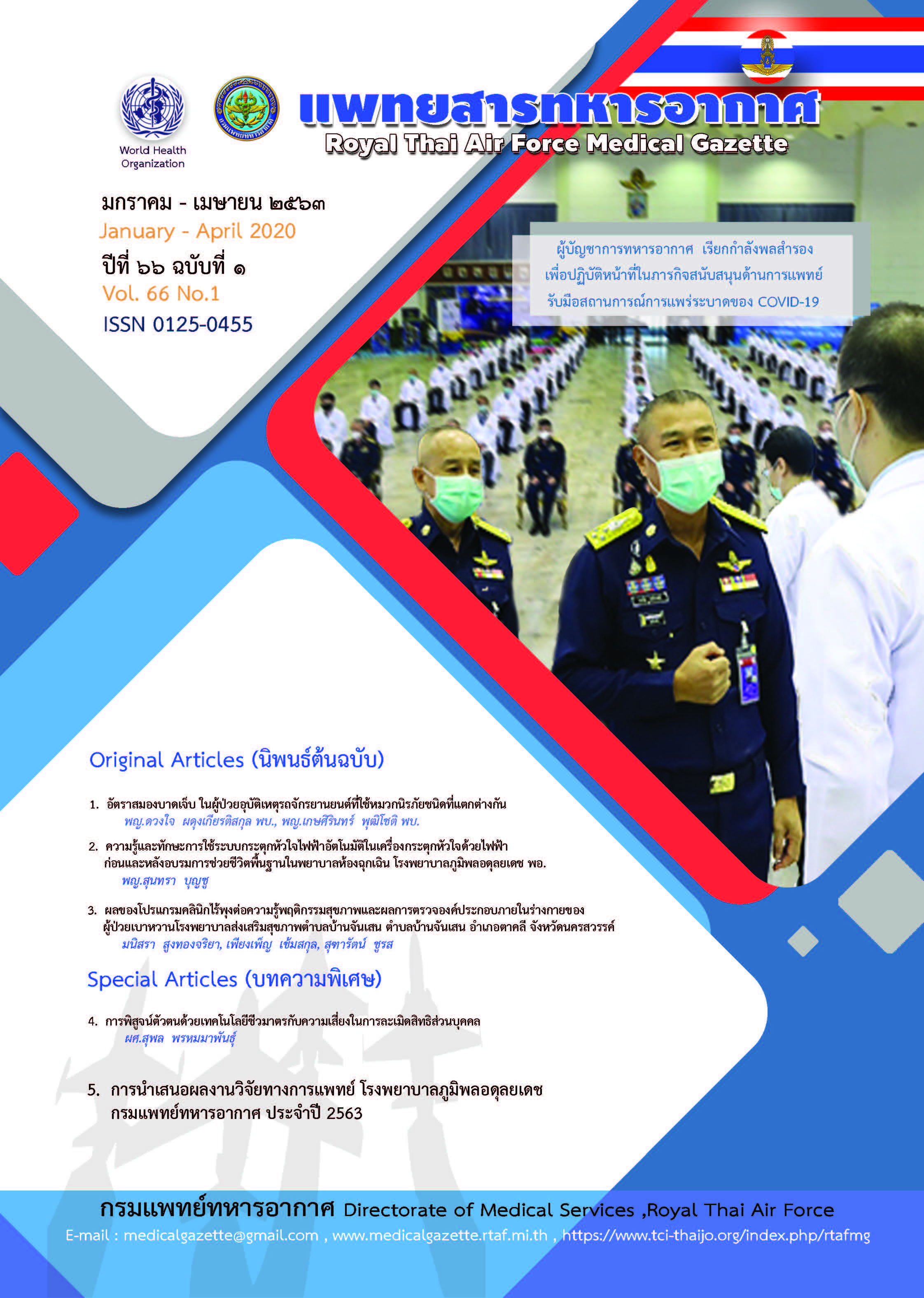Knowledge and Skills of Using Automate External Defibrillation Mode in Defibrillator before and after Basic Life Support Training Program in Emergency Room Nurses of Bhumibol Adulyadej Hospital
Main Article Content
Abstract
Background : Therefore, it is committed to the develop knowledge and skills of using automate external defibrillation mode in defibrillator by organizing the training of basic life support for emergency room nurses of Bhumibol Adulyadej Hospital, because they are often encountering emergency situations.
Objective : To assess knowledge and skill of using automate external defibrillation mode in defibrillator in emergency room nurses before and after the training, and determine factors associated with ability of basic life supporting.
Material and Method : The study evaluated data and related factors before and after the training of basic life support (2015 AHA Guidelines for CPR and ECC) of 92 emergency room nurses. The knowledge assessment was conducted in the same day.
Results : The score of multiple-choice knowledge before and after training has mean + SD equal to
7.15 + 1.24 points and 9.2 + 0.788 points marks respectively, which were significantly different P-value less than 0.001. The score of multiple-choice and practice after training compare in each group experience no significant difference p-value 0.316 and 0.214 marks respectively. The score of multiple-choice and practice after training compare in frequency of CPR in 1 month, no significant difference p-value 0.895 and 0.810 marks respectively. The score of multiple-choice and practice after training compare in frequency of using AED in 1 month, no significant difference P-value 0.055 and 0.107 marks respectively. Rescue workers have score of multiple-choice before training 8.25 + 0.70 points, nursing have score 7.05 + 1.23 points. Rescue workers scored significantly higher p-value 0.008 however, multiple choice and practice score after training no significant difference P-value 0.107 and 0.297 marks respectively.
Conclusion : The result of assessment showed that scores of theoretical knowledge and skill of basic life support have increased clearly. This basic life-support training improves the capacity of emergency room nurses. Rescue workers who often have the chance to perform resuscitation and use AED, have basic knowledge before training better than nursing. In addition, learning and developing basic life support skills not related to work experience and frequency of resuscitation. Everybody can improve their skills after training.
Article Details
บทความที่ได้รับการตีพิมพฺเป็นลิขสิทธิ์ของวารสาร
References
Association Guidelines for Cardiopulmonary Resuscitation and Emergency Cardiovascular
Care. Circulation. 2015;122:S685-S705.
2. The Public Access Defibrillation Trial Investigator. Public-access defibrillation and survival
After out-of-hospital cardiac arrest. N Engl J Med. 2004;351:637-64.
3. Valenzuela TD, Roe Dj, Nichol G, Clark LL, Spaite DW, Hardman RG. Outcomes of rapid Defibril-
lation by security officers after cardiac arrest in casinos. N Engl J Med. 2000;343:1206-9.
4. Afzalimoghaddam M, Talebideloi M, Talebian MT, Farahmand Sh. Evaluation of the Effective-
ness of Basic Life Support Training on the Knowledge and Skills. Patient Safety and
Quality Improvement Journal.2014;2(2):73-6.
5. Bloom B.S. Taxonomy of educational objectives. Hand book II The affective domain. New York:
David Mckay; 1956.
6. Theresa MM, Cordula K, Christoph H. Basic life support skills of high school students before and
after cardiopulmonary resuscitation training: a longitudinal investigation. Scandinavian
Journal of Trauma, Resuscitation and Emergency Medicine. 2012;20:1-7.
7. Shrestha R, Piryani RM, Sharma MW. Basic life support: knowledge and attitude of medical/
paramedical professionals. World Journal Emergency Medicine. 2012;3:141-5.
8. Ura S, Supattra U, Tippamas C. Factors Related to Nurses’ Knowledge and Skills in Cardiopul-
monary Resuscitation in Songklanagarind Hospital. Songklanagarind Journal of Nursing.
2012;1:1-10.


